Colin Haley’s Clothing System for Alpine Climbing in the Chaltén Massif
6,000 words about dressing for alpine climbing you didn’t know you needed to know.
Last year, I spent two months climbing in the Chaltén Massif, in southern Argentine Patagonia. It is a mountain range where I have done a huge amount of climbing over the past 15 years, and over that time I have slowly refined my clothing systems. This post is for those of you who like to geek out on your gear as much as I do, and hopefully some of my fellow gear nerds will appreciate it.
In roughly descending order of importance, these are the foundations of my clothing system, anytime I’m climbing mountains anywhere.
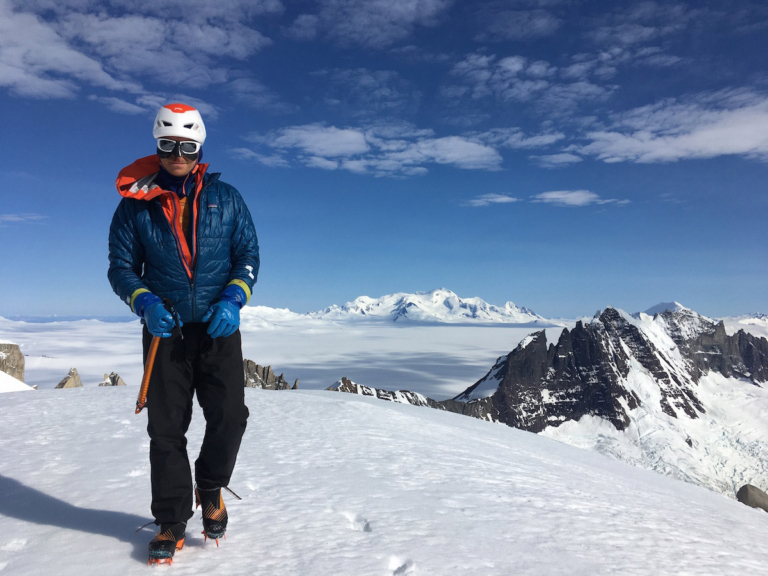
Colin Haley on the summit of Cerro Domo Blanco after a traverse from Cerro Piergiorgio. “Despite the beautifully clear skies, we descended from here rather than continuing our planned traverse, due to a very pessimistic weather forecast. Descending in beautiful weather we were constantly second-guessing our decision, but a few hours later the wind gusts were so strong that hiking on flat ground was difficult, and we knew we had made the right call.” Photo: Alex Honnold
Total Insulation
At any given moment in time, I must be able to wear every item of clothing that I brought with me on a climb (the exceptions to this rule are gloves and socks). The total insulation value of all my layers worn at once must be great enough for the environment I’m climbing in. A good rule of thumb for myself is that if I bring enough clothing to be comfortable for all planned circumstances (while belaying at night, for instance), then I’ll have enough warmth to make it through an unexpected circumstance, like an unplanned open bivouac. I wouldn’t by any means be comfortable at an unplanned open bivouac, but I would feel safe from hypothermia. When I was younger, I used to pack lighter in terms of total insulation, taking the bare minimum I could get away with. Not only did that not leave much of a safety margin in case of unexpected circumstances, it also meant that I spent a lot of time on alpine climbs being uncomfortably chilly. Looking back, I think this probably wasted a lot of energy—more energy than would have been spent carrying the mass of a bit more total insulation.
Total Mass
I want the total mass of my clothing system to be as small as possible. Like all of the gear that we bring with us on climbs, every additional gram of clothing is carried over thousands of meters of technical terrain, and the less mass of equipment we carry, the better we climb. Obviously having minimum mass is at odds with having maximum total insulation, so with all of my clothing choices I am always evaluating the warmth-to-weight ratio of each item of clothing.
Wind/Water Protection
For pretty much any truly alpine environment, having clothing that will completely block the wind is important. When the wind gets strong (as it tends to do in high mountains, especially in Patagonia), not having an outer layer to block the wind drastically reduces the insulation value of the rest of your clothing. Whether or not you need a waterproof layer depends on the environment and circumstances in which you’re climbing. In a really cold environment, like on Denali or on 8,000-meter peaks, a waterproof layer is usually superfluous. In a place where the temperature often fluctuates right around freezing, a waterproof layer can be very important. Wind protection is essential in any high-alpine environment, and water protection might be important or might not be.
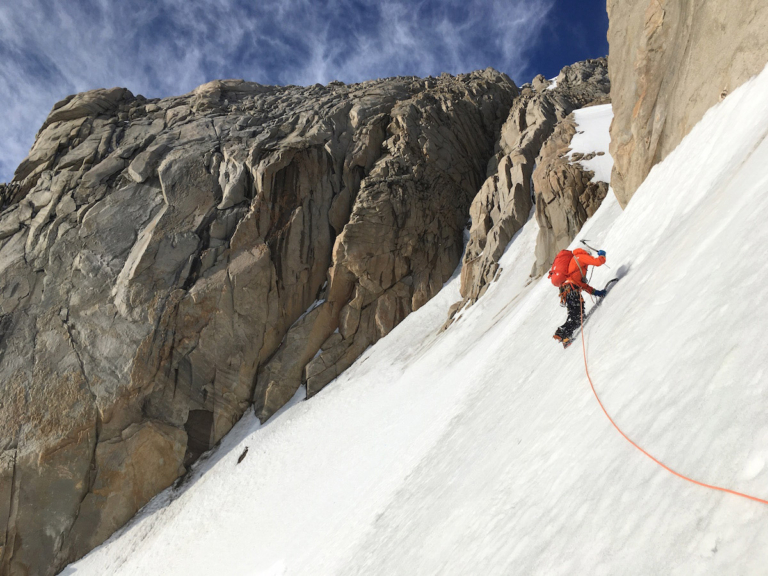
Colin Haley climbing Cerro Domo Blanco after a long traverse of Cerro Piergiorgio. Photo: Alex Honnold
Freedom of Movement
Climbing totally naked gives the best freedom of movement, but obviously isn’t realistic in a high-alpine setting. Highly technical climbing requires a very large range of motion (much more than trail running or skiing, for instance), and the ideal clothing system is the one that hinders that movement the least. Your clothing system should not only allow you to have full range of motion, but it should do so without wasting energy. For example, many soft-shell pants allow you to highstep, but you have to dramatically stretch the fabric every time that you do, and when you add up the thousands of times over the course of a big alpine climb that you highstep, you are wasting a lot of energy repeatedly stretching that fabric.
Insulation When Wet and Drying Time
In many alpine climbing situations, it is not realistic to expect your clothing will always be dry. A sudden wave of spindrift can catch you with your hood down. You might have to momentarily climb through running water in the middle of a simul-climbing block, when it’s not possible to stop and put on a waterproof jacket. For these reasons, it is important to have clothing that can keep you warm enough when it’s wet, and clothing that can dry out quickly. Purely synthetic items of clothing tend to dry fastest, but there can still be a lot of variation between different types of synthetic fibers (nylon fibers absorb much more water than polyester fibers, for instance), and different fabric constructions.
The following clothing system is what I used on all of my alpine climbing this season in Patagonia, with a few minor variations that I’ll mention below. For reference, I think I am slightly smaller than a standard Patagonia size M, but M is my usual preferred size, with some exceptions.
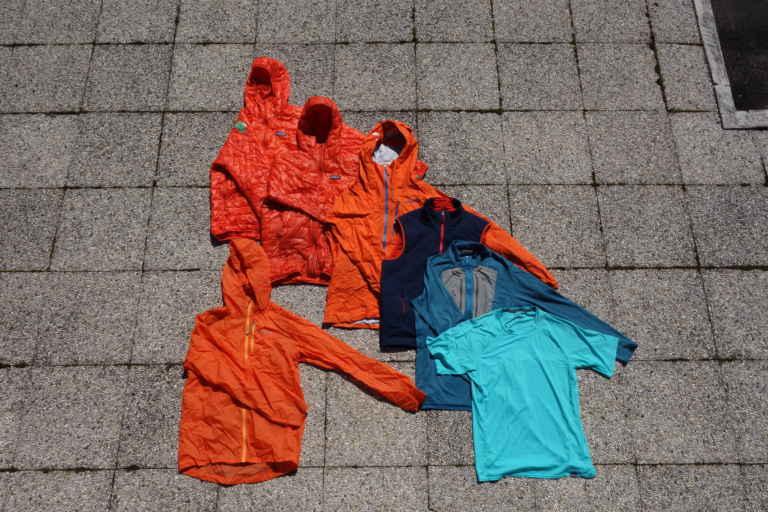
Colin Haley’s upper-body layering system in the Chaltén Massif. Note that either an M10 Jacket or a Houdini Jacket are brought on a climb, but not both. Photo: Colin Haley
1) Puffy, Insulating Jackets—Micro Puff® Hoody/Jacket, M (two of ’em)
Since it came out a few years ago, the Micro Puff is the puffy jacket that I use more than any other. It is made with very light fabric, and with fast-drying synthetic insulation so lightweight that many people mistakenly think it is down. It has a warmth-to-weight ratio that seems as good as down, but with the benefits of synthetic.
For most of the alpine climbing that I do, including in the Chaltén Massif, a single Micro Puff® Jacket is not enough insulation. Rather than bringing a heavier, warmer puffy, my preferred system is usually to bring two Micro Puff Jackets. When it’s warm, they’re both in my pack. When it’s chilly I wear one, and when it’s cold I wear both of them. I used to bring one in size S and one in size M, but I realized more recently that I prefer to bring both in size M. The baggier fit gives me better freedom of movement when climbing.
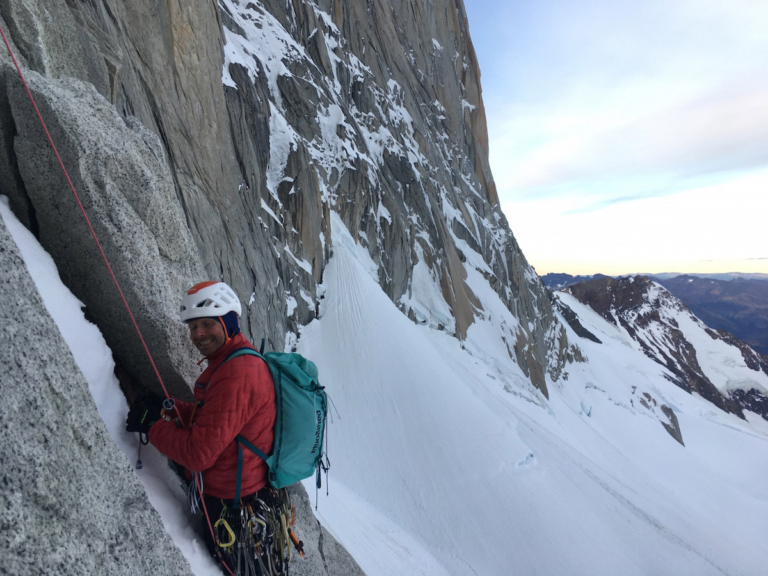
Colin Haley simul-rappelling down to the Glaciar Piedras Blancas, following a traverse of Aguja Guillaumet, Aguja Mermoz, and Aguja Val Biois. Photo: Alex Honnold
I used to nearly always get my jackets in the hooded version. More recently, I have decided that I prefer to have fewer hoods. The way I see it, if you can’t comfortably wear all of your hoods at the same time, then clearly you have too many! These days I prefer to have a bit more insulation directly on my head (often two balaclavas at once—see below), and only a couple of hoods. I feel that I have an easier time moving my head around this way. So, even though the photo in this blog post shows two of the Micro Puff Hoodies, my preferred system these days is to wear one Micro Puff Jacket and one Micro Puff Hoody. Also, on a couple climbs this season that were particularly cold, I brought one Micro Puff Hoody and one Macro Puff® Jacket, instead of two Micro Puff jackets.
Lastly, this fall Patagonia came out with the new DAS® Light Hoody. It is very similar to the Micro Puff Hoody, but I feel that the warmth-to-weight ratio is even slightly better, and it has a chest pocket, which I find extremely useful. So, as you might guess, it is my new favorite puffy jacket. My system for alpine climbing this winter will be exactly as described above, except with two DAS Light Hoodies, rather than two Micro Puff Jackets.
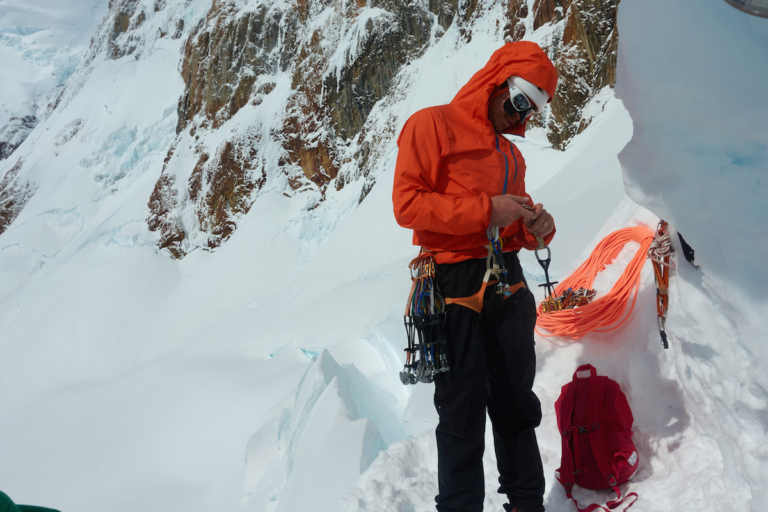
Colin Haley racking up at the base of Cerro Torre’s south face. Photo: Fabian Buhl
2) Shell Jacket—Houdini® Jacket, M or M10® Anorak, M
There have been a few different iterations of the M10® Jacket, none of which are currently available, but they can all be described in roughly the same way: a full-on shell jacket (as in, a shell with a membrane, aka “waterproof breathable”) that is as lightweight as possible. This version, the M10 Anorak, was the lightest, most minimalist version that has been made. I have come to realize that overall, I prefer full-zip jackets to pullovers, but of course the half zipper saves weight, and makes the jacket more comfortable and supple under your harness.
The Houdini® Jacket is, in my opinion, the single most useful, important item of clothing that I own. It is very simple: just an incredibly lightweight windbreaker. I use it for everything from trail running to climbing 7,000-meter peaks. Its minimal weight is not its only advantage compared to an M10 Jacket—it is also more breathable than a jacket with a membrane, and nicer to move in, because the fabric is so supple and slippery.
Whether I bring an M10 Jacket or a Houdini Jacket depends on whether I think I need a waterproof layer, or merely something windproof. Your preference can depend on the sort of terrain you plan to cover (an ice gully, where spindrift pours down, or a rocky ridge?), the general climate of the place you are in (a super dry place, like Antarctica, or a really humid place, like the Cascades?), and of course the weather forecast. If the forecast is good, my general rule of thumb in the Chaltén Massif is to bring an M10 if climbing on the Torres peaks, and a Houdini if climbing on the Fitz Roy peaks. The Torres are much more alpine peaks, with snow and ice on many of the features, so even if the weather is very good it’s normal to get showered with running water and bits of ice or to climb your way through vertical snow. Even though they are not far from the Torres, the Fitz Roy peaks are much drier, so in good weather a reliable windbreaker is often all that you need.
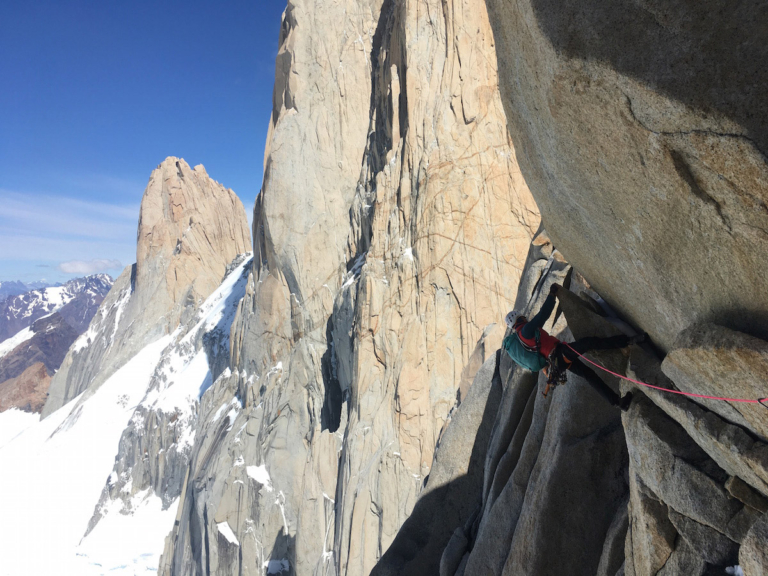
Colin Haley traversing from Aguja Mermoz to Aguja Val Biois. Photo: Alex Honnold
3) Midlayer Insulation—Nano-Air® Vest, S
The Nano-Air® Vest has become one of my favorite items of clothing in the past couple of years. I find that a vest is often a great way to slightly boost the total insulation of a clothing system. Because a vest covers your torso it makes a significant difference to how warm you feel. Because a vest doesn’t cover your arms, it doesn’t affect freedom of movement much, and is thus well suited to technical climbing.
The Micro Puff® Vest has a better warmth-to-weight ratio than the Nano-Air, but I have found that I prefer the Nano-Air Vest. For me, the fit of the Nano-Air Vest seems better than the Micro Puff, which could be because Nano-Air fabric is stretchy, while Micro Puff fabric is not. In addition, the Nano-Air Vest has a chest pocket, which I always appreciate.
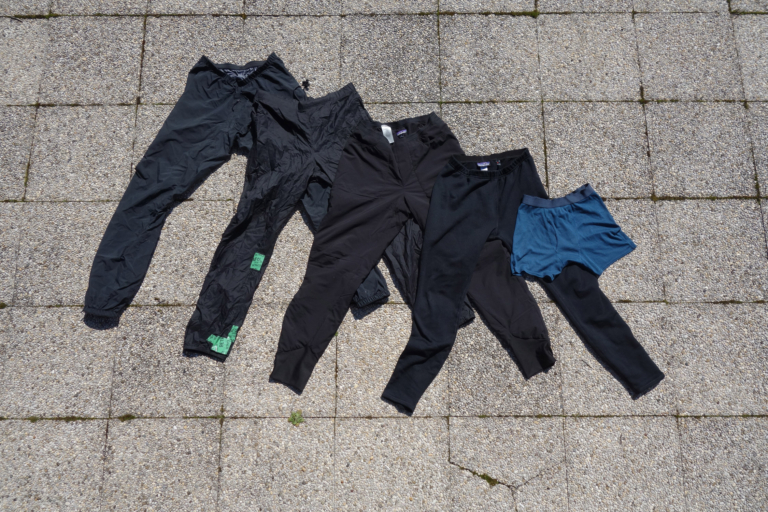
Colin Haley’s lower-body layering system in the Chaltén Massif. Note that only three total items are brought on a climb. For the shell pants he chooses either the Houdini Pants or the prototype hardshell pants. For the insulation layer he chooses either the Nano Air Pants or the powerstretch fleece tights. Photo: Colin Haley
4) Near-Skin Insulation—Capilene® Thermal Weight Zip-Neck, M
Over the years Patagonia has referred to this weight of Polartec® grid-backed fleece as R0.5 (which I personally find to be the most logical name), Capilene 4, and now Capilene Thermal Weight. Regardless of the name, I find it very useful, and wear this layer for almost every mountain activity that I do. On mine I have made one very significant modification—I’ve added two chest pockets, both kind of tall. Unfortunately, most people don’t seem to want chest pockets on a baselayer so Patagonia doesn’t make them that way, but for me they are very useful, because there are many items that are best kept closer to the body, and therefore warmer—phone, camera, skins, an energy bar (to keep it soft enough to eat), or even water (these pockets are just barely big enough that I can put in a 500ml water bladder). I wanted them tall enough to be able to put in skins (only skins from skimo racing skis will fit) or a water bladder, but I also wanted them to be narrow, so that my phone stays vertical in the pocket.
5) Baselayer—Capilene® T-Shirt, M
For places or scenarios warm enough that I might end up wearing just a shirt for a large amount of time, my preferred baselayer is the Airshed Pullover. This is because it provides a lot of sun protection and some wind protection without adding heat (perfect for hiking up a hot, sunny glacier). However, for scenarios in which my baselayer is almost always buried beneath other layers, I use a more traditional Capilene baselayer, which is a bit more comfortable and I think has a slightly better warmth-to-weight ratio.
In combination with the Capilene Thermal Weight fleece, I usually prefer a Capilene T-shirt in lieu of a long-sleeved Capilene shirt. This is partly because I prefer to have a bit more insulation on my torso than on my forearms, but also because it makes it very easy to push my sleeves up to my elbows when I want to have bare forearms; a very effective and quick way to vent when you start to overheat, particularly useful for difficult sections of rock climbing.
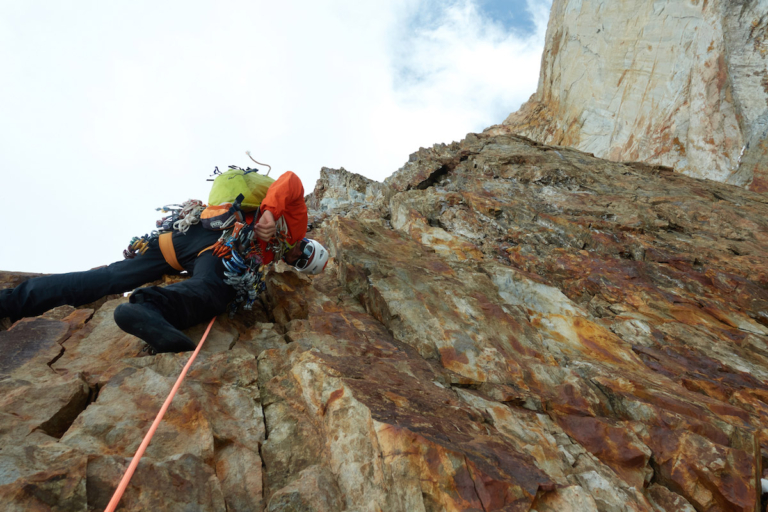
Colin Haley attempting a new route on the south face of Cerro Torre. “We aborted our attempt quite low down, due to horrendously loose rock.” Photo: Fabian Buhl
6) Shell Pants—Houdini® Pants, L, or Prototype Full-On-Ninja-Shell-Pants, M
This past season in Chaltén (and for pretty much all alpine climbing I’m doing anywhere these days) I was always taking one of two different pairs of shell pants. One pair, the Houdini® Pants, are ultralightweight and windproof, but not waterproof. The other pair are still very lightweight thanks to their minimalist design but are waterproof. The decision to bring the windproof pants or the waterproof pants depends on the exact same factors as the decision of which shell jacket to bring, described above. In the Chaltén Massif I would usually bring waterproof pants on the Torres, and windproof pants on the Fitz Roy peaks.
If the Houdini Jacket is the single most useful item of clothing that I own, then the Houdini Pants are the second. They weigh almost nothing, block the wind, and have good breathability. I use them year-round for all sorts of different activities. It was only last year that I finally thought to try them in size L. It seems surprising that I would try them in size L, considering that I use some Patagonia products in size S, but I am very glad that I did. I already loved the Houdini Pants, but having them in size L makes the freedom of movement absolutely superb. The cuff has an extra plastic button to adjust the tightness of the cuff, so even though I’m not really a size L they never go under my heels. There is also a drawcord on the waist of the current Houdini Pants (that I personally add a cord-lock to), which also makes it possible for me to wear a larger size. While alpine climbing, I always have some sort of insulation layer underneath the Houdini Pants, but for multipitch rock climbing in warmer weather, I wear them next to skin. In this application they block the wind and provide exceptional freedom of movement, but obviously wouldn’t work well on a climb with much offwidth and chimney climbing, since they are so thin. If you are interested in trying Houdini Pants for climbing, I highly recommend sizing them one size larger than you wear in other Patagonia pants. The biggest problem with Houdini Pants for alpine climbing is that the bottom of the pants closes with just a couple of snaps, and thus snow can come inside. For a future experiment I might try sewing a zipper on instead.
Obviously, Houdini Pants don’t offer enough protection for all alpine-climbing scenarios, and sometimes I choose to take full-on hard-shell pants with a membrane. I find most hard-shell pants disappointing since they are often much heavier than necessary, and usually do not have very good freedom of movement. This is usually partly because of unnecessary features (such as full side-zips, which add a lot of weight, bulk and stiffness), and mostly because the cut of the pants is not optimized for range of motion. Over a year ago, I started a lengthy one-on-one process with Patagonia designer Eric Noll to make a better pair of hard-shell pants for climbing. We spent a lot of time discussing the design options and tried a few different prototypes. The result is far and away the best hard-shell pants I have ever worn. They are very feature-minimal (basically just a fly, elasticized cuffs, elasticized waist, and nothing else), but the real advantages are in the cut. Eric used judo pants as his inspiration for designing a cut that would have the least possible resistance to high-stepping and stemming. One very important aspect of making a good cut in hard-shell pants is throwing fashion out the window. Another Patagonia tester already noted of these prototypes, “I find the butt to be very baggy and as a result dumpy feeling, not the most attractive pant.” The excess of fabric in the butt might not conform to fashion but is critical to being able to high-step without any restriction. To my delight, it seems that these prototypes are on their way to becoming a real Patagonia product soon, and so far, it seems that journey has not burdened them with extraneous features or eroded the excellent fit.
One thing to note is that I almost never climb in soft-shell pants, even though they are quite popular. Compared to hard shell, soft shell is much heavier, less windproof and less waterproof. The one major advantage to soft shell is its greater durability, and thus I would choose soft shell for alpine rock climbs that involve lots of chimneys, offwidths or other thrutching against abrasive rock. Even for climbs that are more on snow, ice and mixed terrain, it is pretty normal to get tears in your hard-shell jacket or pants during a big climb. However, with the right tape, hard shell tears are extremely easy to repair well. Several years ago, in Patagonia, an Austrian climber showed me what truly good repair tape is, and it has majorly improved my gear repair. Really good repair tape is tape made for connecting together sections of housewrap (such as Tyvek). It comes with a removable backing, and the adhesion is extremely good, such that I’ve never had it come off, no matter how many times I wash a jacket. Before removing the backing, you can easily cut it with a pair of scissors to exactly the size and shape needed to repair the tear. The brands I have used (which are all good) have, for whatever reason, all come from Switzerland, Germany or Austria: Wigluv (by SIGA), Rissan (by SIGA), Betrafol, and Ampacoll. A friend from Alaska, who does some construction work, has told me that Tyvek tape is just as good, but I haven’t tried it myself. I suspect that any tape that doesn’t have a backing (tape that is rolled onto itself) is not sticky enough. In addition to clothing, this tape is also great for repairing backpacks and tents, and I’ve heard it even easily repairs leaks in air mattresses.
7) Leg Insulation—Nano-Air® Pants, M
For leg insulation, on all of my recent alpine climbs I used the Nano-Air® Pants. They’re kind of like high-tech sweatpants and have a baggy fit. The current Nano-Air Pants are noticeably baggier than the first version, which I have heard other Patagonia ambassadors lament, but personally I think it is a welcome improvement, because there is excellent freedom of movement. In fact, excellent freedom of movement is the thing I like most about the Nano-Air Pants.
8) Undies—Capilene Boxer Briefs
Nothing super high tech here—just some good undies made from good synthetic fabric. In everyday life I almost always pull the waistband down when peeing, but when wearing a harness I often appreciate a fly.
9) Capilene Thermal Weight Balaclava and Prototype Capilene Silk-Weight Balaclava
A normal ski hat is great for skiing, hiking or hanging around camp, but on a technical climb I always prefer to use a balaclava. Balaclavas tend to be thinner than ski hats (and therefore work better with helmets), and offer much more protection, since they completely cover your head and neck. Recently, I have been using a system of two balaclavas: one is a very thin silk-weight, and the other is thicker and warmer. Unless it is really warm out, I wear the silk-weight balaclava for essentially the entire climb. It adds a bit of warmth and protects my ears and neck from the sun. Between my helmet, the silk-weight balaclava and my sunglasses with nose-guard and cheek-guards, I pretty much don’t have to use sunscreen at all, except on my lips. Whenever it gets colder, I put the thermal-weight balaclava on over the silk-weight one, and together they both fit comfortably under my helmet. The silk-weight balaclava that I have is a prototype from many years ago, but the new Capilene™ Air Balaclava would probably work in a similar way, providing a bit of warmth and sun protection while still being cool enough that it can be worn for the entire climb.
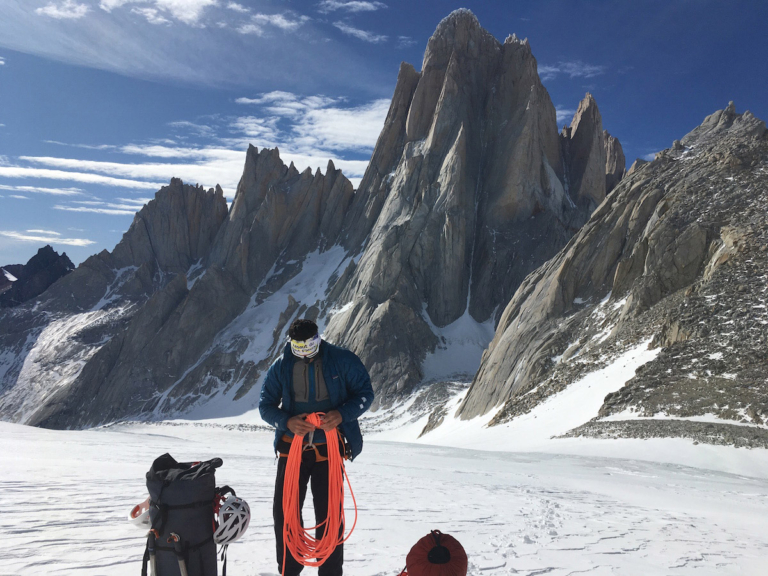
Colin Haley approaching Cerro Piergiorgio, with the west face of Chaltén (AKA Fitz Roy) behind. Photo: Alex Honnold
10) Random Headband That I Got at a Ski Mountaineering Race
For a long time, I didn’t really “get” headbands. If it’s cold out, why not wear a real hat? In the past few years, I have become a big fan of headbands, but for sun protection, not for insulation. While hiking or skiing (on the approach to a climb, for instance) this headband completely protects my forehead and ears from sunburn without making me feel hot. Many people use baseball-style hats or visors for the same purpose, but I have never liked the way that a brim obstructs your vision when looking up. Also, even the most ultralight, minimalist, brimmed hats are bulkier and heavier than a thin little headband.
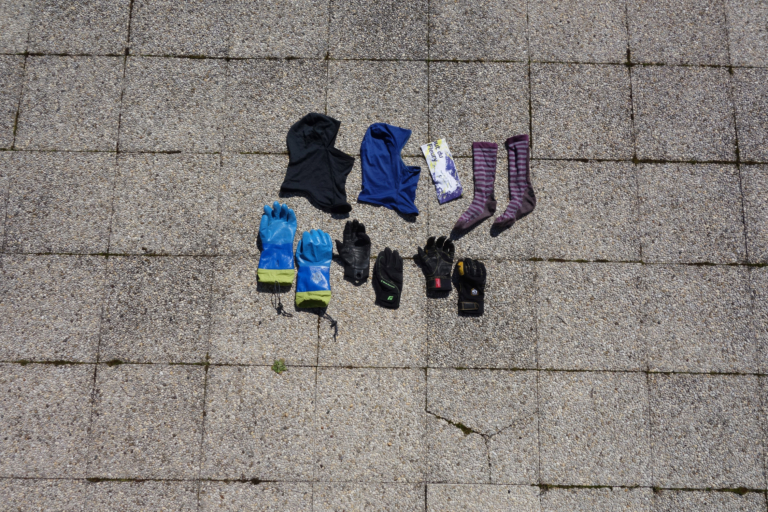
Colin Haley’s hats, gloves, and socks. Note that only one pair of thin gloves are brought on a climb – either the Torque Gloves or the Ergro Grip Active gloves. Photo: Colin Haley
11) Wool Socks
The pair of socks pictured here are the ones I wore the most during this past Patagonia season, but in fact I go on every expedition with a variety of different socks to keep my options open. My primary goal when picking what socks to wear is always to get the best possible climbing performance in my boots. What thickness of socks I choose depends on what boots I am wearing, and how tight I want them to feel. Contrary to what many beginners might think, in a given pair of boots your feet will almost always be warmer in thinner socks, and colder in thicker socks. If your socks are too thin, then your boots will be too loose, and the climbing performance will be diminished. If your socks are too thick, your circulation will be reduced, and your feet will be cold. If you change the thickness of your insoles, you may need to change the thickness of your socks to reach a similar tightness. I usually find that to get a high-performance, zero-slip fit from a pair of socks I have to order a size that is supposedly too small for my measured foot size. Almost always, the socks that are advertised to be my size are too loose for good climbing performance.
I think that you usually can achieve the best climbing performance by wearing a single pair of socks, because wearing two pairs of socks creates one more interface between fabrics and creates more opportunity for your feet to slip around in your boots. However, I often end up wearing two pairs of socks simply to achieve the perfect tightness in my boots, or sometimes even three pairs to be able to incorporate vapor-barrier socks.
During the past year or so I have been experimenting with synthetic socks, because they should theoretically absorb less water than wool socks, and accordingly dry faster. While I haven’t yet come to any firm conclusions, at this point I think that wool socks are probably the better choice because to me they feel less slippery than synthetic. The more slippery your socks are, the more likely your feet will slip around in your boots (like getting heel lift when standing on your front points).
The way that different wool socks are woven can affect how good their climbing performance is. As a general rule, the more luxurious and cozy a sock feels, the worse the climbing performance will be. A luxurious, cozy sock is one that has a very airy knit, slides onto your foot easily, is very stretchy, and has lots of terry loops that make it feel cozy (often referred to as cushioning). By contrast, I think the socks with the best climbing performance are not very stretchy (and thus can be a slight struggle to get on) and feel very dense, almost like boiled wool.
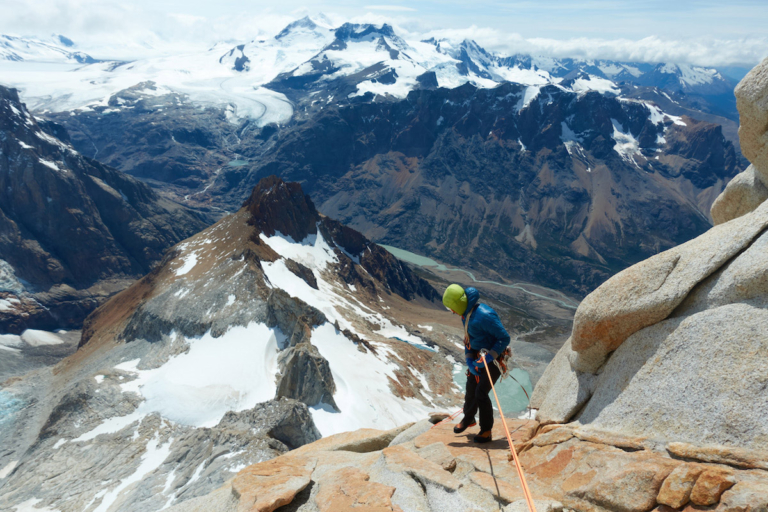
Colin Haley descending Aguja Guillaumet, after a one-day car-to-car enchainment of Cerro Electrico and Aguja Guillaumet. Photo: Fabian Buhl
12) Black Diamond Torque Gloves, M or Hestra Ergo Grip Active, size 9
For technical alpine climbing, the most important gloves are your thinnest ones, for wearing while leading difficult pitches. If you are just ice climbing or dry-tooling then you don’t need super good gloves, but for alpine mixed climbing it is also common to grab rock holds with your gloved hands, and then you really notice a big difference in performance between different gloves. A fun test is to see what holds on a hangboard you can still hang onto while wearing various gloves. My favorite gloves for leading hard mixed pitches are the Torque Gloves by Black Diamond, and the Ergo Grip Active Gloves, by Hestra. They both have strengths and weaknesses.
The Torque gloves are very thin, very sticky and very dexterous. I have never used any other gloves that allow me to hold onto small handholds as well as these do. The best thing about these gloves is that they are made purely from synthetic materials, so they dry quickly and don’t lose too much of their insulation value when they are wet (which will inevitably happen with any gloves when alpine climbing). The Torque gloves are not very warm (although massively warmer than being bare-handed), so it is important that they maintain a good portion of their warmth when wet. Many years ago, I tried alpine climbing with gloves of a similar thickness, made with a leather palm, and will never do that again. Leather gets really cold when it is wet, so any glove that puts leather directly against your skin is a bad idea for alpine climbing. The downside to the Torque gloves’ purely synthetic construction is that they are less durable than gloves made with leather. It takes a lot of use to wear an actual hole in them, but it doesn’t take all that many rappels before the supersticky palm material becomes not-sticky-at-all palm material. One thing to note is that the current Torque gloves run a little bit bigger than Black Diamond’s other gloves. For example, I can’t get my hands into a size S Punisher glove or Terminator glove, but I can get my hands into a size S Torque glove. It’s a bit of a struggle though to get my hands in a size S, so I bring size S only for things like multipitch mixed climbs (where you don’t need to move so fast, and you are climbing pitches near your limit), and for alpine climbing (where you take your gloves off and on so many times during the day) I stick with size M.
When you put your hands in a pair of Ergo Grip Active gloves, it is immediately obvious that Hestra makes nothing other than gloves, and that they have been making gloves for nearly a century—the fit, at least for my hands, is absolutely amazing. I hadn’t really realized how poor the fit was on my other gloves until I wore these. It really is clear that a lot of effort goes into making their patterns perfect. The Ergo Grip Active gloves don’t allow me to hang on to quite as small of holds as the Torque gloves do, but they are noticeably warmer, so I think the dexterity-to-warmth ratio is about the same. These gloves are made with leather palms, which brings advantages and disadvantages. The big disadvantage is that these gloves are much slower to dry than the Torque gloves, but at least there is no leather against your skin, so they still feel warm when they get wet. The advantage is that these gloves are more durable than the synthetic palm material of the Torque gloves.
The Ergo Grip Active gloves are nearly twice as expensive as the Torque gloves, but I wouldn’t be surprised if they last nearly twice as long (and definitely have a better fit). The biggest, most important difference between the two gloves is that one is slightly more dexterous, and the other is slightly warmer.
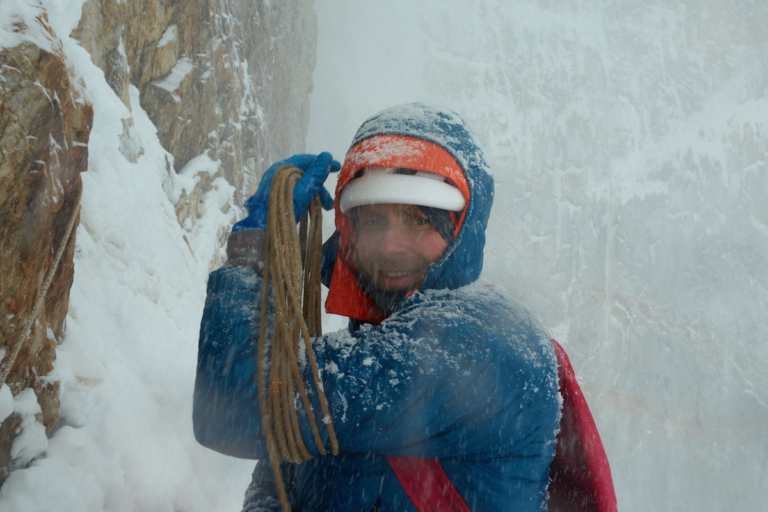
Colin Haley bailing off the lower south face of Cerro Torre in stormy weather. Photo: Fabian Buhl
13) Showa TEMRES 282 Gloves, L
These have been some of my most commonly used gloves for a few years now. I originally learned about them from a longtime friend and climbing partner in Seattle, Dan Aylward, who found them in a commercial fishing store and realized they work as well in the mountains as they do for handling frozen fish. A few years later I learned that in Japan (where they are made) many other alpine climbers had come to the same conclusion, and they are very popular gloves among Japanese alpinists.
The TEMRES are not the “rubber gloves” that they look like. For this series of gloves, Showa somehow made them somewhat breathable. They aren’t actually very breathable, and they can easily get wet with sweat (although I think this is the case with almost all warm mountaineering gloves), but they are definitely more breathable than a normal pair of rubber gloves. Showa also makes an uninsulated version of the same gloves, but I have not found them to be very useful.
So, what is great about these gloves? I think they have a superb warmth-to-weight ratio, an excellent dexterity-to-warmth ratio, they’re more waterproof than any gloves made specifically for mountaineering, they’re drastically more durable than they look, and they’re an outrageously good value compared to most good mountaineering gloves.
The fit of the TEMRES 282 is a bit inaccurate and loose—a far cry from the exceptional fit of the Hestra Ergo Grip Active. The reason they still have pretty good dexterity despite their poor fit is because there are no layers within the glove that can slide on one another. Any glove that has a removable liner will inevitably have a bit more slip than these gloves in which the insulation is bonded directly to the shell. Many high-end mountaineering gloves are made with a “waterproof-breathable” membrane inside (such as GORE-TEX or BDry) but in many cases this construction causes the gloves to lose a lot of climbing performance. For example, try hanging on a medium-size crimp wearing a TEMRES 282 on one hand, and a Black Diamond Terminator (a glove with similar warmth) on the other hand. Immediately you will realize that in the Terminator glove the various layers are slipping around inside (“waterproof-breathable” membranes are usually very slippery), and it is much more difficult to hold on.
Two issues with the TEMRES 282 is that they can get pretty stinky inside if you’re wearing them every day, and they are slow to dry. Both of these issues are due to poor breathability. One thing I’ve realized though is that if you turn them completely inside out (which is pretty easy to do), they dry significantly faster, and don’t get as stinky.
Another issue with the TEMRES 282 is that snow gets inside of them. On all of my pairs that I use for climbing (as opposed to skiing) I sew on a gauntlet, which can be made out of any old piece of nylon or polyester. This is key to making them good alpine-climbing gloves. It seems that Showa has caught wind of people modifying their gloves in this way, and just recently came out with a new version that has a gauntlet sewn on!
Another downside to the TEMRES 282 is that, unlike many gloves made specifically for ice climbing, there is no padding for your knuckles. This is less of an issue now that so many people use axes like the NOMIC, but sometimes you can still take a painful hit on one of your knuckles.
By far the biggest problem with the TEMRES is that the palm material does not provide very good friction compared to many gloves designed specifically for climbing. On the rubber grip of an ice axe, it’s good enough (unless the shaft gets snowy or icy), but for grabbing snowy rock holds, it’s pretty poor. For climbing in Patagonia in the austral summer, I use these gloves more for belaying, following or rappelling, and not for leading hard pitches, so the friction of the palm material remains good enough. For a place cold enough that I would be leading many pitches in warm gloves (like the Denali Diamond, for instance), I would instead pick warm gloves designed for maximum grip in climbing scenarios. Such gloves would almost certainly be heavier than the TEMRES, less waterproof and much slower to dry, but would have better climbing performance for the same warmth. Traditionally these gloves for me were the Punisher by Black Diamond, but they have gotten much worse since their original version. Having now seen how excellent the Hestra Ergo Grip Active are, I suspect a warmer pair of Hestra gloves would be ideal for this scenario (leading many technical pitches in a very cold environment).
The TEMRES gloves have some downsides, but they have a lot of excellent qualities (ultralight, waterproof, dexterous), and considering that they cost less than $20 per pair, they are an amazingly good value compared to gloves designed for mountaineering. One thing to note is that the sizing on the TEMRES gloves is smaller than you are likely accustomed to. So, for example, if you wear size M in Black Diamond gloves, you will probably want to try the TEMRES 282 in size L.

